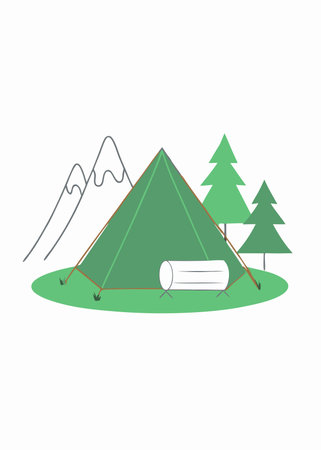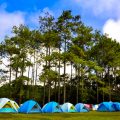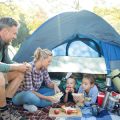1. Layered Clothing and Insulation
When it comes to cold-weather camping in the fall, staying warm and dry is all about dressing in layers. Temperatures can swing drastically throughout the day—from sunny afternoons to chilly nights—so having a smart layering system keeps you comfortable no matter what Mother Nature throws your way.
Why Layering Matters
Layering helps trap heat and allows you to adjust your clothing based on the weather and your activity level. It also ensures moisture doesn’t build up next to your skin, which can make you feel colder over time.
The Three-Layer System
Here’s a simple breakdown of the essential layers for fall camping:
| Layer | Purpose | Recommended Materials |
|---|---|---|
| Base Layer | Wicks moisture away from your skin to keep you dry | Merino wool, synthetic fabrics (like polyester) |
| Mid Layer | Provides insulation by trapping body heat | Fleece, down, or synthetic insulated jackets |
| Outer Shell | Protects from wind, rain, and snow | Waterproof and breathable materials like Gore-Tex or similar fabrics |
Tips for Choosing Each Layer
Base Layer Tips:
- Avoid cotton—it retains moisture and takes forever to dry.
- Look for snug-fitting tops and bottoms that move with you.
Mid Layer Tips:
- Down is warmer but loses insulation when wet; synthetics are better in damp conditions.
- A zip-up fleece is great for quick ventilation when youre active.
Outer Shell Tips:
- Your shell should be roomy enough to fit over other layers comfortably.
- Pit zips or venting options help regulate body temperature during hikes.
Dressing smart with layers not only keeps you warm but also lets you adapt quickly to changing fall weather—one of the keys to enjoying your cold-weather camping trip.
2. Cold-Weather Sleeping Systems
When the temperatures drop during fall camping trips, staying warm through the night becomes a top priority. A solid cold-weather sleeping system can make the difference between a cozy night under the stars and a long, uncomfortable one.
Choosing the Right Sleeping Bag
Start with a sleeping bag that’s rated for colder temperatures than you expect. Fall nights in many parts of the U.S. can dip into the 30s or even lower, especially in higher elevations. Look for sleeping bags with temperature ratings between 0°F to 20°F for reliable warmth. Down insulation offers great warmth-to-weight ratio, but synthetic fill performs better in wet conditions.
Sleeping Bag Temperature Ratings Guide:
| Temperature Rating | Best For |
|---|---|
| 0°F to 15°F | High elevation or northern states in late fall |
| 15°F to 30°F | Typical fall conditions across most of the U.S. |
| 30°F and above | Milder climates or early fall camping |
Don’t Forget Insulated Sleeping Pads
A good sleeping pad does more than just cushion — it insulates you from the cold ground. Look for pads with an R-value of at least 4 for chilly fall nights. If you tend to sleep cold, consider stacking a foam pad underneath an insulated air pad for extra warmth and protection.
Tips to Stay Warm Overnight
- Layer Up: Wear thermal base layers to bed and avoid overdressing — too many layers can trap moisture and make you cold.
- Use a Hot Water Bottle: Fill a Nalgene bottle with hot water and place it near your core or feet inside your bag.
- Avoid Going to Bed Cold: Do some jumping jacks or light activity before crawling into your sleeping bag to warm up your body first.
- Keep Your Head Covered: A beanie or hoodie helps retain body heat, as a lot is lost through your head.
- Avoid Moisture: Make sure your gear is dry before sleeping — damp clothes or bags will sap warmth quickly.
A well-thought-out sleep system tailored for cold weather will keep you comfortable and safe, letting you enjoy those crisp autumn mornings feeling well-rested and ready for adventure.
![]()
3. Four-Season or Cold-Weather Tent
When youre heading out for a fall camping trip, especially in regions where temperatures can drop quickly and early snow is a possibility, a reliable tent is more than just shelter — its your first line of defense against the elements. A four-season or cold-weather tent is specifically built to handle lower temperatures, strong winds, and even light snowfall that can surprise you during autumn adventures.
Why Choose a Cold-Weather Tent?
Unlike standard three-season tents, cold-weather tents are made with sturdier materials and reinforced poles to provide extra durability in harsh conditions. They also feature better insulation and fewer mesh panels to keep warm air inside and block chilly drafts.
Main Benefits of a Four-Season Tent:
| Feature | Benefit |
|---|---|
| Heavier Fabric & Insulation | Helps retain body heat and blocks out cold air |
| Reinforced Poles & Structure | Withstands strong fall winds and unexpected snow loads |
| Low Ventilation Openings | Reduces condensation while keeping heat in |
| Full-Coverage Rainfly | Adds an extra layer of protection from wind and moisture |
Ideal Conditions for Using One
If youre camping in mountainous areas, northern states like Montana or Vermont, or anywhere that could see sudden weather changes in the fall, a four-season tent gives you peace of mind. Youll sleep warmer, stay drier, and feel more secure when the wind starts howling at 2 a.m.
Pro Tip:
Look for models with vestibules so you can store wet gear outside your sleeping area without exposing it to the elements.
4. Reliable Heat Sources and Cooking Gear
Staying warm and well-fed is key to enjoying your fall camping trip, especially when the temperatures start to drop. Having reliable heat sources and the right cooking gear ensures youre comfortable and can enjoy hot meals and drinks at your campsite.
Safe Portable Heaters
When it comes to heating, safety should always come first. Portable propane heaters made for indoor or tent use are a great choice for cold-weather camping. Always check for features like automatic shut-off in case the heater tips over or detects low oxygen levels. Some popular options include:
| Heater Model | Fuel Type | Safety Features |
|---|---|---|
| Mr. Heater Buddy | Propane | Tip-over & Low-Oxygen Shutoff |
| Campy Gear Chubby 2-in-1 | Butane/Propane | Built-in Safety Valve |
Cold-Weather-Rated Stoves
Not all camp stoves work well in colder temps. In freezing weather, fuel efficiency drops, especially with standard butane canisters. Look for stoves designed for cold conditions—those that use liquid fuel or isobutane-propane mixes tend to perform better. Here are a few good options:
- MSR WhisperLite Universal: Compatible with multiple fuel types, reliable even in freezing temps.
- Jetboil Flash: Fast-boiling system that works well with Jetboil’s fuel mix, ideal for quick meals or drinks.
Essential Cookware for Warm Meals & Drinks
The right cookware can make a big difference on chilly nights. Choose lightweight yet durable materials like stainless steel or hard-anodized aluminum. Don’t forget insulated mugs and thermoses to keep drinks warm longer.
| Cookware Item | Description |
|---|---|
| Nesting Pot Set | Saves space and includes pots of different sizes for varied meals. |
| Insulated Mug | Keeps coffee or tea hot while you relax around the fire. |
| Coffee Press Attachment | Adds comfort with a fresh cup of coffee in the morning. |
| Lightweight Skillet | Perfect for eggs, bacon, or stir-fry dinners at camp. |
Pro Tip:
Bring along extra fuel canisters—you’ll burn through more fuel than usual trying to stay warm and cook food in colder weather.
5. Lighting and Power Essentials
As the days get shorter and the nights grow longer in the fall, having the right lighting and power gear becomes essential for a safe and comfortable camping experience. Whether youre cooking dinner after sunset or finding your way to the restroom at 3 a.m., reliable lighting can make all the difference.
Must-Have Lighting Gear
When youre out in the woods during colder months, you cant always count on natural light. Here are a few lighting essentials every fall camper should pack:
| Gear | Why You Need It |
|---|---|
| Headlamp | Keeps your hands free while walking, setting up camp, or cooking. Look for models with adjustable brightness and a red-light mode to preserve night vision. |
| Lantern | Perfect for lighting up your tent or picnic table area. Choose battery-operated or rechargeable lanterns with multiple brightness settings. |
| Flashlight | A solid backup in case your headlamp or lantern fails. Compact but powerful models work best. |
Power Sources Matter
Colder temperatures can drain batteries faster than usual, so its important to plan ahead when it comes to power:
- Extra Batteries: Always bring more than you think youll need, especially if your gear uses AA or AAA batteries. Store them in a dry, insulated container to protect from the cold.
- Portable Power Banks: These are a must for charging phones, GPS devices, or rechargeable lights. Opt for high-capacity banks (10,000mAh or more) that can handle multiple charges.
- Solar Chargers: A great eco-friendly option if youre staying out for more than a couple of days. Just keep in mind that shorter days mean less sunlight—so use this as a backup rather than your main source.
Pro Tip:
If youre using rechargeable batteries or devices, keep them close to your body during the night to prevent them from losing charge due to cold weather.
6. Safety and Emergency Supplies
When youre camping in the fall, especially in colder weather, conditions can change quickly. A sunny afternoon can turn into a chilly night or bring sudden wind and rain. Thats why having the right safety and emergency supplies is just as important as your tent or sleeping bag. Heres a breakdown of essential gear that can help you stay safe when the unexpected happens.
First-Aid Kit
A well-stocked first-aid kit is non-negotiable for any camping trip. In cooler weather, minor injuries like cuts or blisters can become serious if not treated properly. Make sure your kit includes:
- Bandages in various sizes
- Antiseptic wipes and ointment
- Gauze pads and medical tape
- Tweezers and scissors
- Pain relievers (like ibuprofen)
- Cold pack for swelling
- Emergency contact info and any personal medications
Emergency Blankets
Also known as space blankets or Mylar blankets, these lightweight, compact sheets are designed to reflect body heat. If someone gets wet or suffers from hypothermia, wrapping them in an emergency blanket can help stabilize their body temperature until help arrives or they warm up again. Keep at least one per person in your gear.
Hand Warmers
Even with gloves, your hands can get uncomfortably cold during fall nights. Disposable hand warmers are small packets that produce heat when exposed to air — perfect for warming up fingers inside gloves or pockets. Theyre inexpensive, easy to pack, and last several hours.
Weather Radio
A portable NOAA weather radio helps you stay informed about incoming storms or sudden temperature drops — something a phone cant always guarantee when youre off the grid. Look for a model with multiple power sources like hand-crank and solar charging so youre never left without updates.
Quick Gear Reference Table
| Item | Purpose | Why Its Essential for Fall Camping |
|---|---|---|
| First-Aid Kit | Treat minor injuries quickly | Prevents small issues from becoming big problems in cold weather |
| Emergency Blanket | Retains body heat | Counters hypothermia risk during unexpected cold snaps or wet conditions |
| Hand Warmers | Keeps extremities warm | Makes cold nights more comfortable; helps prevent frostbite in fingers/toes |
| Weather Radio | Receives real-time alerts | Keeps you aware of changing weather when cell service isn’t available |
Tip:
Store all emergency gear in one dry bag thats easy to grab in a hurry. That way, if the weather shifts fast, youre not digging through your entire backpack looking for hand warmers or a flashlight.


